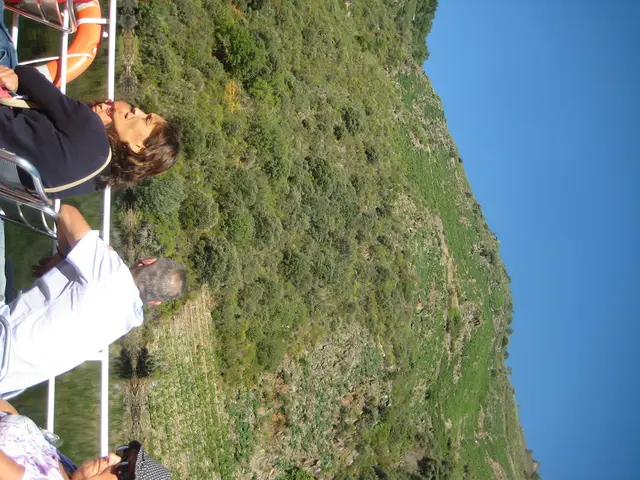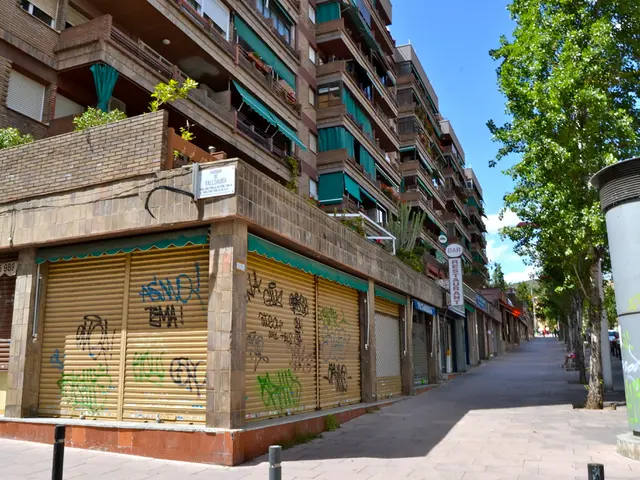Discovered Treasures in Algarve: My Top 20 Unconventional Algarve Hideaways and Coastal Retreats
In the sun-soaked south of Portugal, the Algarve region is not just about the boozy Brits and big resort hotels in Albufeira. There's a whole secret Algarve to discover, a hidden gem trove that's been overshadowed by its more popular counterparts. If you're ready to venture out and uncover some real treasures, here are some of my favorite off-the-beaten-path spots you should not miss.
Moonlit History in Silves
If you're up for a trip into the heart of the Algarve, Silves should be on your list. This mysterious town, often overlooked by visitors, offers a slice of history where you can feel the echoes of ancient Moorish rulers. The crown jewel here is the impressive Moorish castle that perches atop the hill, shielded by orange groves (you can almost taste those sweet oranges as you breathe in the air).
Once you've had your fill of castle-gazing, pop into the old mosque-turned-church to get a feel for the region's Islamic past. Or, if you're up for it, visit during Silves' Medieval Festival in August and time-warp into a bygone era as the streets come alive with historical reenactments, parades, stalls, and activities.
Alcoutim's Smuggler's Past
Head to Alcoutim, nestled along the Guadiana River that traces the border between Spain and Portugal. Kick back and watch the foot traffic on the river with boat trips or take the more adventurous route and zip across the border—quite literally. Limite Zero's speedy zip line will have you soaring through the air and crossing borders in no time.
Every other year, Alcoutim comes alive during the Festival of Contraband, a celebration of the region's smuggling past. A temporary floating bridge connects Portugal and Spain, and the festivities include stalls, music, and events that will leave you feeling like you've stepped into a one-of-a-kind experience.
Castle Marim's Time Warp
If you're into castles, Castro Marim has got you covered. It stands tall and sentinel at the Guadiana River, marking the border and watching over its surroundings as it has for centuries. Inside its walls, you can wander amongst remnants of medieval torture devices (if you dare), and in August, you can join the masses at the medieval festival where the entire town takes a trip back in time.
Lower down, just outside the town limits, you'll find a selection of salt pans that produce some of the best and most organic Flor de Sal available. Get a taste of the authentic saltscape by lounging in the summer salt baths or learning about the harvesting process at Salmarim. For a truly memorable experience, consider splurging on a combined salt pans and private cooking session with Chef Noélia Jerónimo—one of Portugal’s Master Chef judges.
Tiny Tranquility in Cacela Velha
If you're seeking a breath of fresh air and incredible views, Cacela Velha is your ticket. This diminutive village clings to a cliff at the end of the Ria Formosa lagoon system, offering a panoramic vista that's worth the journey alone. Though there's not much here, besides a couple of cafes and a church, the ocean views—especially at low tide—are jaw-dropping.
Don't forget to take the staircase down to the dive-worthy beach, but keep the tides in mind to avoid getting stranded on the sandbar when the waves rise.
Recovered Charm in Vale de Bispo
For a unique place to stay in the Algarve, venture slightly inland to Aldeia da Pedralva, a restored rural village that's been turned into a boutique hotel of sorts. Here, the old homes have been transformed into cozy rooms, and the former café and post office still stand, offering a slice of authenticity. The surrounding trails are serene and tranquil—the perfect escape from the tourist hustle and bustle.
Seasonal Delights in Tavira's Outskirts
Tavira is one of my favorite places in the Algarve, and its outskirts don't disappoint. You can search out the Tavira salt pans, where flamingos can be spotted during the winter months (November–March), or take a bike ride through the salt-encrusted landscape during the warmer months.
Head inland and you'll find the Pego do Inferno waterfall. It may be dry during the late spring and summer months, but it gives a relaxing spot to rest your weary feet during the winter months. Finally, grab a boat and head to Ilha de Tavira, one of my favorite beach islands in the Ria Formosa. The journey—while short and cheap—feels like a true adventure.
Adventurous Exploration in Alvor
Ifyou're looking for a different take on the Benagil Cave, Alvor's coastline—near Praia de Boião—has its share of hidden gems. Take a snorkeling or canyoning tour with Zip&Trip's small group and let a local marine biologist guide you through these secret underwater wonders. It'll be a fresh dive into the Algarve's aquatic world.
Historic Treasures in Estoi
Just outside Faro, Estoi holds a pair of Algarve hidden gems that are ripe for discovery. The Roman Ruins of Milreu give you a glimpse into the region's ancient past, with surviving mosaics and parts of the walls and temples.
For an elegant stay, set your sights on the Pousada de Estoi, a grand building turned luxury hotel. It's the perfect spot to imbibe a bit of grandeur, with a chilled glass of wine on the veranda offering stunning views you'll struggle to find elsewhere in the Algarve (and if you'd like to experience Turkish baths and boutique luxury, just book a room).
Carnival Culture in Loulé
Loulé is a picturesque inland town that's managed to hold onto a more traditional way of life, even amid the tourist invasion. Workshops focused on preserving Algarvian handicrafts are a testament to that. There's also a castle and the standout Art Nouveau market hall to explore.
Loulé truly comes to life during its annual Carnaval de Loulé, the largest carnival celebration in the Algarve. Don't miss the vibrant three-day affair if you're in the area during February—it's sure to offer a colorful and joyful experience.
Old-World Charm in Alte
A short drive from Loulé brings you to the picturesque village of Alte, which oozes a slower-paced and more storied way of life. Though it's gotten more tourist-friendly, many bus tours move on quickly, giving you the opportunity to enjoy its charms at a more leisurely pace.
Watermills and small canals make for a great picnic spot, while the area's best waterfall awaits a short walk from the village—its chilly waters offer a refreshing dip, especially during warmer months.
A Walk in the Park
The Castle of Paderne's ruined fortress walls may not inspire much, but the trail that passes nearby is a pleasant walk with sites like a nearby mill where you may catch a glimpse of turtles in the river.
Coastal Nostalgia in Carvoeiro & Ferragudo
Though their populations are small, both Carvoeiro and Ferragudo have become popular tourist spots during the summer months. Visit during the off-season, however, and you'll find them much more peaceful. In Ferragudo, you can catch fishermen tend to their nets and bring in their catch while Carvoeiro boasts a small beach, a clifftop boardwalk, and wave-battered Algar Seco rock formations and pools.
Green Escapes in Estombar's Fontes
This municipal park is a local favorite for a nature-filled escape, and it's still a bit of an unknown to tourists. The park offers a host of picnic tables and six BBQs, making it the perfect spot for a homegrown feast. Take a leisurely stroll around the park and along the Arade River estuary to admire the od-water wheel, amphitheater, and miller's house—and keep an eye out for flamingos during the season.
A Tipple in Marmelete
In Marmelete, a tiny village en route between Monchique and the west coast, you can see how one of the Algarve's local liquors, medronho, is made. This fruit brandy, often called firewater, can be enjoyed in bars across the region. Here, you can learn more about the brewing process and even visit brewing spots, often extensions of peoples' homes, with prior arrangements.
Wine Tasting in Lagoa & Silves
Lagoa has grown dramatically in the past 30 years but still offers a more local town feel with vineyard tasting experiences like Quinta dos Santos—a craft beer and winery that offers cellar-door tastings and tapas. In Silves, there are also more traditional vineyards and wine experiences to enjoy.
If you're in Lagoa during the first week of July, don't miss the nighttime Candlelit Market—a beautiful time to wander and see the streets.
Chapel Nossa Senhora da Rocha & Seven Hanging Valleys Trail
Chapel Nossa Senhora da Rocha, perched on a cliff high above the ocean, serves as a starting point for the Seven Hanging Valleys Trail. Fringed by sandy bays on either side, this clifftop chapel offers stunning views—it's the perfect place to sit with a good book and gaze out at the ever-reaching Atlantic.
A Cemetery of Anchors
Praia do Barril, on the Ria Formosa Natural Park, is home to the strange 'cemetery of anchors'. These anchors were laid out here after the demise of the tuna industry, creating a unique and odd sight. To reach this beach, you can take a sand-dune-backed walk, hop on a little train, or use the lagoon-crossing bridge. Once you get to Praia do Barill, turn left and journey up the beach to find a quieter spot. If you keep walking, you'll eventually arrive at Ilha da Tavira.
Octopus Capital of Portugal—Santa Luzia
Santa Luzia, a small fishing village near Tavira, is famed in Portugal as the country's octopus capital. Nearly every restaurant in the village is dedicated to this local specialty—you can find it fresh and prepared in numerous ways.
West Coast Vibes in Aljezur
The Algarve's west coast is teeming with surfing spots, empty beaches, small villages, and farming valleys. Aljezur is one such village, offering a glimpse into the region's rich history. Wander the 10th-century Moorish castle—known for its characteristic Al' prefix—and explore the museums dedicated to religious art for a taste of the area's bygone era.
Costa Vicentina's Wild Beauty
The Costa Vicentina offers a treasure trove of wild beaches, from windswept bays and dune-backed stretches to surfing hotspots and hidden coves. Though some beaches have become popular, you can still find plenty of secluded spots, especially outside the peak summer months. Take a road trip and explore the coastline, detouring down minor roads to uncover your own little slice of Algarve hidden gem paradise.
Serene Village of Querença
The small and pristine whitewashed village of Querença is a testament to its commitment to culture and literacy. Visit the square and church—the village's central hub—for a taste of local life, or take a short walk through part of the park, which is popular for birdwatching. Don't miss the chance to grab a slice of their famous almond cake.
In Silves, you can immerse yourself in the history of the Algarve while enjoying the charming lifestyle, exploring the hidden gems such as the Moorish castle and old mosque-turned-church. In Alcoutim, step back in time at the Festival of Contraband, celebrating the region's smuggler's past and offering a unique experience on the Guadiana River.




